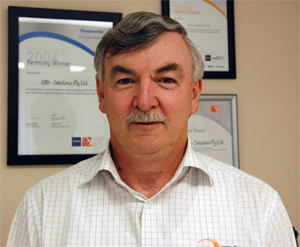Back to Basix for EMS

profile With the amalgamation of the electricity industry in New South Wales hitting Australian software developer EMS Solutions hard, the company had to code itself out of a bind.

Allen Matthews(Credit: EMS Solutions)
Allen Matthews, the managing director of EMS, said that the three-year R&D project, which would eventually become its Basix product line, was initially a platform to help aid internal software development.
"We did it hard," Matthews said. After being founded in 1995, the company faced a challenge later that same year when the number of electricity utility businesses in the NSW electricity industry was amalgamated from 26 down to six, cutting EMS's client base and revenue stream significantly.
"It became very difficult to sell our utility-based ERP product (which was built on the UNIX platform) mainly because the look and feel was not windows based like Microsoft's products which clients preferred at the time," said Matthews.
"We had to re-invent the business and the product, and the company switched its platform from UNIX Open Systems to Microsoft in 1997 and we have never looked back. "
The introduction of Basix at EMS has also meant that the company was able to cope with having to reduce its staff from 28 in 2005 to 15 at present. According to Matthews, the company is currently able to produce twice as many products and services for its clients, with half the staff.
"Instead of having software developers writing pages of code, we're able to have consultants sit down with customers, understand their business and then prototype the software — sometimes in front of them," said Matthews, describing Basix's strengths as a configuration tool to aid in development.
"Our consulting staff can now very quickly create and deliver bespoke or packaged solutions for the SMB, mid market or enterprise market and tailor these to fit 100 per cent of client requirements at very low cost. This can be done without developer coding effort or compiling source code for delivered product," he said.
However, it didn't come easy. According to Matthews, over $4 million was spent on the research and development of Basix.
While some of the funds were raised through a government software grant, the company raised the bulk of the money through its own revenue.
The staff, according to Matthews, played a key role in the transition.
"The secret to our success was that we had staff that were able to adapt and change to a new platform," he said, adding that it was no easy task for some of the staff who worked with open systems.
"To be successful you have to pick a technology that is mainstream, rather than something off to the sides. I think start-ups can't afford to do that," he said.
Matthews advised start-ups to exercise caution when choosing clients. "You also have to win a client that is prepared to work with you without all the constraints of legal contracts, which can bind you and basically break you."
When quizzed about government support for small software developers, Matthews advised that it was necessary to be pragmatic.
"Sometimes, the time and effort involved in security government grants and facilities is not worth the cost or distraction to the focus of the business," said Matthews.
However, the AusIndustry Commercial Ready Grant that EMS received in 1996 was a step that allowed the company to fund the early commercialisation activities and the proof of concept for Basix.
"In the end the funds were very helpful in allowing EMS to focus on this commercialisation process rather than directing our efforts onto sales during that period," he said.